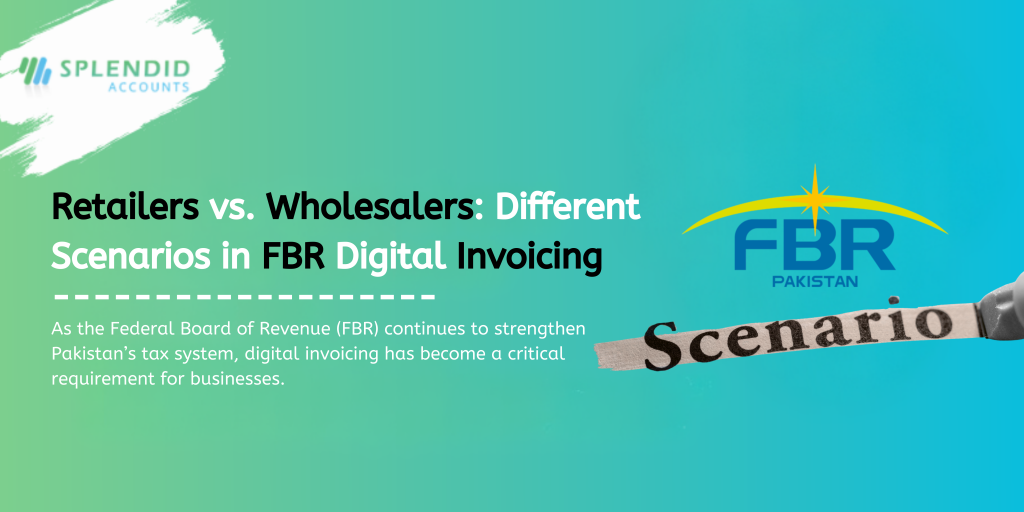
As the Federal Board of Revenue (FBR) continues to strengthen Pakistan’s tax system, digital invoicing has become a critical requirement for businesses. Both retailers and wholesalers are required to generate FBR-compliant invoices, but the scenarios they face can be very different due to the nature of their transactions. Understanding these differences is essential for businesses to remain compliant and avoid penalties.
Why Digital Invoicing Matters?
FBR’s digital invoicing system is designed to:
- Ensure real-time reporting of sales transactions.
- Reduce tax evasion through transparent records.
- Simplify compliance for businesses.
- Provide customers with verified invoices carrying QR codes.
While the objective is the same for all businesses, the invoicing process varies for retailers and wholesalers.
Retailers and FBR Digital Invoicing
Retailers deal directly with end customers in small-volume, high-frequency transactions. Their digital invoicing scenarios typically include:
- Point-of-Sale (POS) Integration
Retailers must integrate their POS system with FBR so that every sale automatically posts to the FBR portal in real time. - Cash and Card Sales
Whether the customer pays in cash, credit card, or mobile wallet, the invoice must be generated instantly with an FBR QR code. - Returns and Refunds
If a customer returns an item, retailers must issue a credit note or reversal invoice to remain compliant. - Discounts and Promotions
Retailers offering promotional discounts must ensure these adjustments reflect in the FBR invoice without compromising accuracy. - Customer Awareness
Since most end customers may not be familiar with tax compliance, retailers are responsible for issuing invoices that clearly show FBR verification.
Wholesalers and FBR Digital Invoicing
Wholesalers operate differently because they usually deal with other businesses in bulk transactions. Their scenarios involve:
- Business-to-Business (B2B) Invoicing
Wholesalers often sell to retailers or distributors. Invoices must include the buyer’s sales tax registration number (if applicable) and comply with FBR requirements. - Credit Sales and Payment Terms
Unlike retailers, wholesalers frequently sell on credit. Digital invoices must reflect payment terms, and FBR requires proper posting even if the payment is delayed. - Bulk Orders and HS Codes
Since wholesalers deal with larger volumes, proper classification of products with accurate HS codes is critical to avoid mismatched reporting. - Returns and Adjustments
Wholesale returns are more complex because they may involve partial deliveries, damaged goods, or order cancellations. Each adjustment must be properly recorded in the FBR system. - Export and Inter-City Transactions
Wholesalers engaged in exports or supplying to different regions must comply with additional documentation, all of which must align with FBR’s digital invoicing system.
Key Differences Between Retailers and Wholesalers
| Aspect | Retailers | Wholesalers |
| Customer Type | End customers | Businesses (B2B) |
| Transaction Volume | High frequency, low volume | Low frequency, high volume |
| POS Integration | Mandatory for daily transactions | Not always POS-based, often ERP-driven |
| Credit Sales | Less common | Very common |
| HS Code Importance | Basic level | Highly critical due to bulk categorization |
| Returns Handling | Simple return/refund process | Complex, involving partial orders or contracts |
Both retailers and wholesalers must comply with FBR digital invoicing regulations, but their operational scenarios differ significantly. Retailers deal with fast-paced customer transactions, while wholesalers manage bulk, B2B sales with complex terms. To remain compliant and efficient, both segments need robust, FBR-integrated software solutions that can handle their specific invoicing requirements.
By adopting the right digital tools, retailers and wholesalers can not only avoid compliance risks but also streamline their operations and build greater trust with customers.
